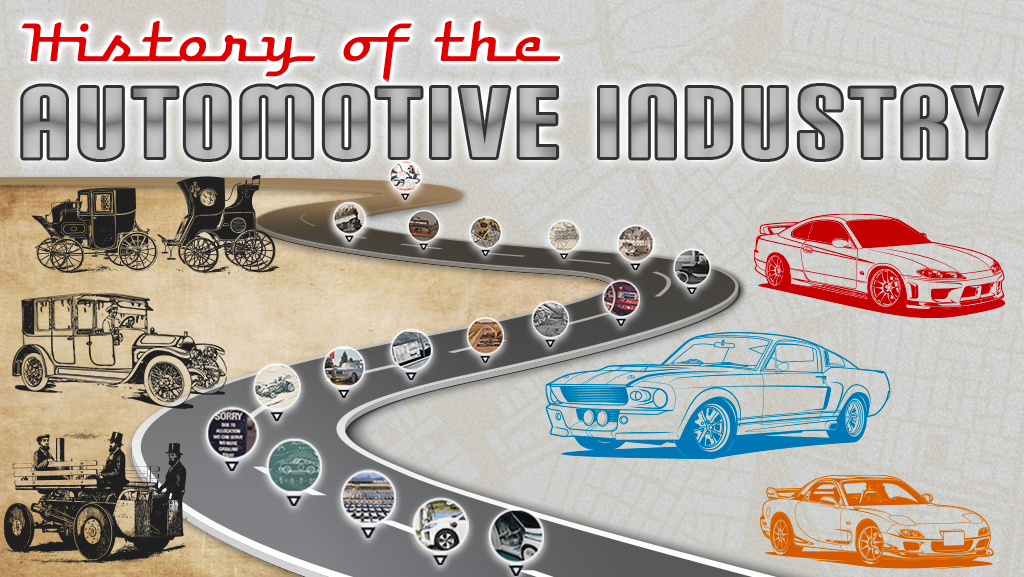
A History of the Auto Industry
Cars have become an important part of our everyday lives. With faster and more-advances cars coming out each year, it’s easy to forget that it’s only been a little over 110 years since we got the first modern cars with Ford’s Model T. Here, we take a look at the history of the automobile and the massive industry behind them, from the earliest horse-drawn carriages to the latest electric vehicles of tomorrow.
Why does America have a love affair with cars?
It is a familiar image in our movies, TV shows, and advertising: a driver behind the wheel and vast expanses of the open road waiting ahead. Why do we keep seeing this image? Because Americans love their cars and the lure of the open road.
While US inventors didn't come up with the internal combustion engine or even the first car, American car manufacturers did refine the industry in many ways. Henry Ford's automated production methods let him sell over 15 million Model Ts in 20 years. The Big Three -- Ford, General Motors, and Chrysler -- built massive auto manufacturing factories and became a staple of the American economy.
In less than half a century from when the first Model Ts rolled off the line, our roads improved to take advantage of newer, faster cars and the freedom they provided. Our Interstate Highway System provided safer and easily accessible routes for travelers going from city to city and state to state. For the first time, people could live away from where they worked.
So what lead us to this point? How did humanity go from walking across continents to driving across the street?
The history of the automobile starts with horses and ends with horsepower.

Taming the first horses
Current archaeological digs show that by 4000 BC, riders were already on horseback in the western parts of the Eurasian Steppe in modern-day Ukraine and West Kazakhstan.
The first wheels would soon appear in Europe and Asia in about 3500 BC. Early wheeled carts were mounted on an axle and used a single horse or team of horses to power them. With chariots, a passenger could quickly use a horse to move them, which was helpful in both battles and races.
Horses, carts, and carriages would remain the dominant means to cross long overland distances for nearly 6000 years before the invention of the first automobiles.
Where did the horse come from? Did all cultures invent the wheel?
Paleontologists believe wild horses originated in the Americas. However, the horse was long gone when European explorers arrived, as a major prehistoric extinction event had wiped them out. In reality, the wild mustangs we're familiar with today came from escaped European stock.
Native American cultures also never built a wheel. South American people used llamas and alpacas as pack animals to haul goods, while North American native populations used boats or traveled on foot until the reintroduction of horses.
In the Middle East and desert areas, camels had jobs similar to horses while being easier to take care of. While they knew of the wheel, desert inhabitants did not use it too often.

The first car takes shape.
In 1478, Leonardo Da Vinci sketched an idea for a self-propelled vehicle, considered by many experts to be the first car ever designed. Large leaf-coiled springs would have regulated the drive mechanism to move the three-wheeled cart. Once the springs uncoiled themselves, they would have to be coiled again for the next leg of any trip.
Found in Da Vinci's journals in the early 1900s, a university team built the cart in 2004. Shockingly, the design worked and would even serve as an inspiration for the latest Mars rovers from NASA. However, it would have been nearly impossible to build back in Da Vinci's time.

Steam power enters the scene.
Inventors and tinkerers modeled and built steam engines as far back as 100 BC. However, the Age of Steam wouldn't officially start until the late 1700s and would run well into the 1800s. Steam-powered trains, ships, and factories helped usher in the Industrial Revolution and truly changed the modern world.
It didn't take long until people began experimenting with using steam power to move carts and wagons. There is much debate about who made the first steam-powered automobile. Ferdinand Verbiest, a Flemish missionary in China, claimed he designed a steam-powered toy cart for the Chinese Emperor as early as 1679.
French inventor Nicolas-Joseph Cugnot designed two versions of his steam-powered Dampfwagen, one in 1769 and one in 1771, for the French military, who wanted an automated cart to transport cannons. The three-wheeled cart tended to tip, leading to the military abandoning the project.
In England, there were a few different versions of steam-powered cars. But across the US and Europe, it was becoming apparent to inventors that a new engine would be needed to turn reliable automated vehicles into a reality.
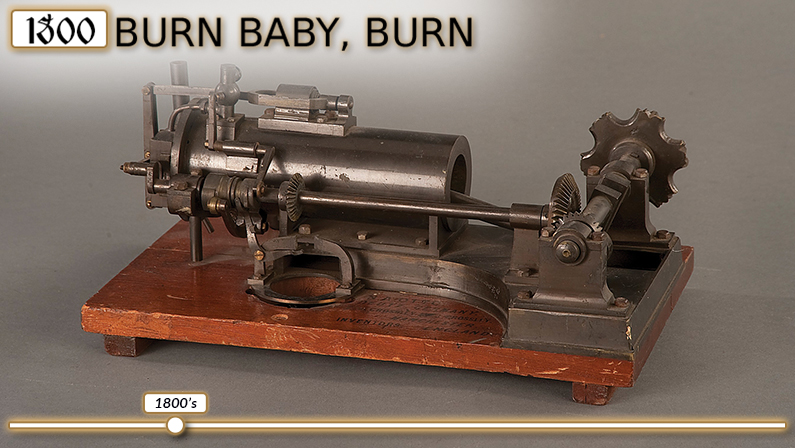
The development of the combustion engine.
Starting shortly after the turn of the 19th century, inventors introduced successive versions of internal combustion engines using different fuels. Some were more successful (and reliable) than others. These engines would lead to the first automobiles as we think of them today.
1807
Francois Isaac de Rivaz, a Swiss inventor born in France, designed what is often considered the first internal combustion engine. His design used a hydrogen and oxygen gas mixture, which, when ignited, created an explosion in the engine's cylinder to drive the piston out, providing power.
At about the same time, French brothers Nicéphore and Claude Niépce built a similar engine running on Lycopodium powder, coal dust, and resin, which they used to power a boat.
Over the next six decades, various changes and other fuels would improve on the basic ideas within these designs.
1863
French engineer Jean-Joseph-Etienne Lenoir invents the "horseless carriage" using the first commercially-successful internal combustion engine.
1867
German designer Nikolaus August Otto improves the internal combustion engine, building the first engine to burn fuel directly in a piston chamber efficiently. In 1877, he made a four-cycle internal combustion engine, the prototype for our modern car engines.
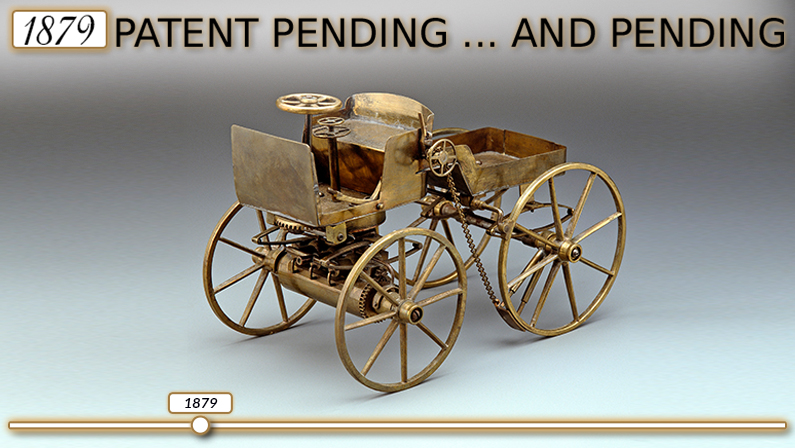
Who was the inventor of the modern car?
George B. Selden filed the first US patents for an engine and four-wheeled car. But due to a series of amendments to the application, the patent office delayed its final approval by 16 years.
The office finally granted his patent in November 1895. He built one car during this time but ultimately never started full production.
While he may not have been building any cars, Selden's shiny new patent caused problems for early carmakers already manufacturing and selling cars while his initial application was still pending.
A few years after finally getting the patent, Selden sold it to John Whitney and his Electric Vehicle Company in 1899. Together they collected a 0.75% royalty on all cars sold.
Later, the rights would go to the Association of Licensed Automobile Manufacturers, who then licensed them to new automobile makers. The association effectively decided who could and could not build cars in the US while getting 1.25% off of all vehicles sold.
When Henry Ford attempted to get his license in 1903, the ALAM turned him down. Officially, the group cited past auto industry associations, including early work with the company that would later become Cadillac. However, the group may have taken issue with his plans to create a low-cost automobile.
Ford sued. The first ruling in 1909 found Selden's patent covered any engine powered by gasoline vapor. Ford appealed, noting that his engines were not based on Selden's redesign of George Brayton's 1872 "Ready Motor" but instead based on Nikolaus Otto's ideas. Ford won on appeal.
With one year remaining on the original patent, ALAM did not appeal the ruling.
Who made the first automobile and when?
While Selden dragged his feet in getting the patent for his car, other US car manufacturers and German carmakers were already rolling out automobiles.
1885 – Carl Benz built the first true car powered by a gasoline engine. It was the first Mercedes-Benz before the company even existed.
1886 – Henry Ford makes his first automobile in Michigan. He would later introduce the moving assembly line.
1886 – Gottlieb Wilhelm Daimler and Wilhelm Maybach introduce the "Cannstatt-Daimler," a four-stroke, four-wheeled car.
1893 – Brothers Frank and Charles Edgar Duryea invented the first successful gas-powered car in the United States.
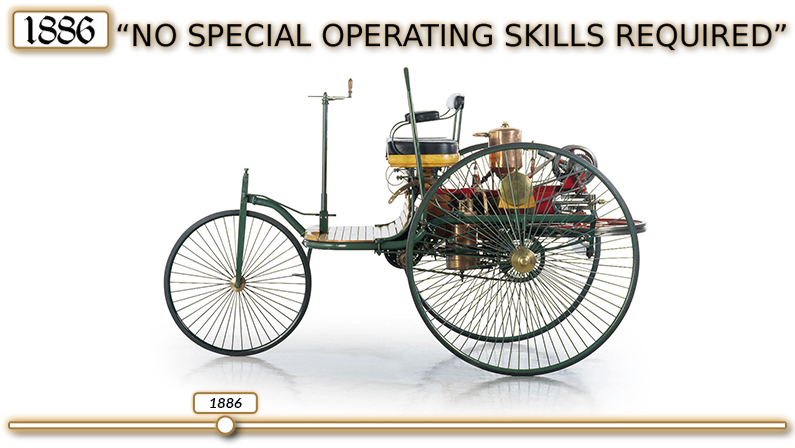
Who built the first car ever made?
In both Europe and the U.S., the wheels of the invention were spinning. Improvements on the basics -- internal combustion engines, fuels to run them, and new auto body designs -- were coming to a head on many fronts. What most historians accept is who filed for patents and when.
On January 29, 1886, in different German cities, both Carl Friedrich Benz and Gottlieb Daimler filed for automobile patents. Benz typically gets credit as the first automaker. He had a working version of his Motorwagen in 1885. German automakers, Italian car designers, and French engineers (among others) were all designing cars around that time.
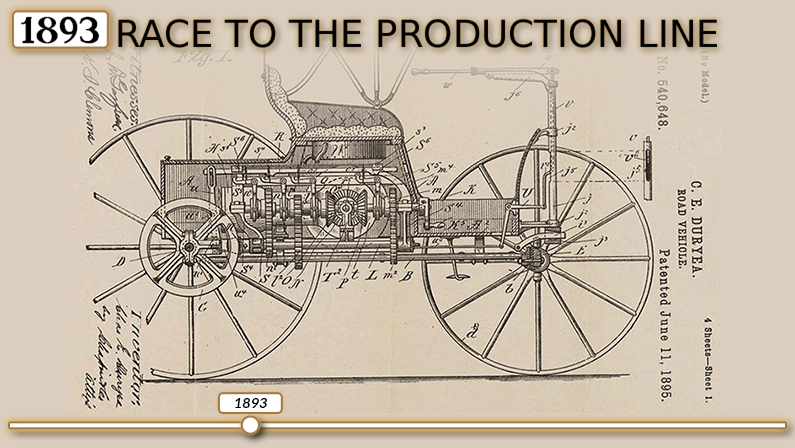
Selling the first cars.
Bicycle mechanics J. Frank and Charles Duryea designed the first successful American gasoline automobile in Springfield, Massachusetts in 1893. On Thanksgiving Day 1895, the duo won the first American car race in Chicago that actually had a car finish. The Duryea Motor Wagon Company would soon be established and made the first-ever sale of an American-made gasoline car the following year. Their original ten production cars were sold in the US.
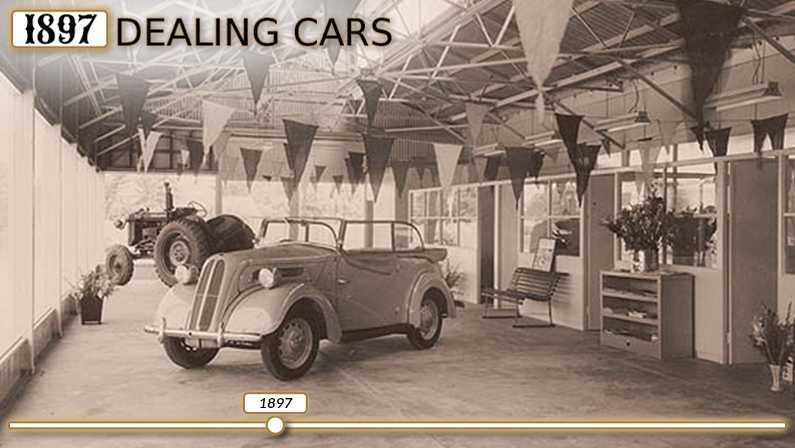
Simplifying the buying process
Sources debate which dealership was "first" to open in the US:
- Independent William E. Metzge's automobile retail showroom opened on June 7, 1897, and sold Waverley electric cars.
- The Reading Automobile Co., first at 126 N. Fifth St. and later at 1411 N. Fifth, in Reading, Pennsylvania, sold Winton automobiles made in Cleveland.
One of the first Ford dealerships was in St. Cloud, Minnesota. The dealership, Tenvoorde Ford, opened in 1903 and is still in operation.
What started the auto dealership industry as we know it?
In its infancy, around 1900, the US automotive industry was a free-for-all. There were hundreds of independent companies making all kinds of unique cars.
During those very early years, makers built cars on demand. There were no inventories for customers to choose from. You could order them from the factory, a traveling salesperson, or via their sales catalog.
Once Ford, GM, and Daimler Chrysler -- the Big Three -- started mass-producing cars, they needed someone to sell them. But their expertise was with designing and manufacturing cars -- not selling them. This would give rise to the franchise system. The automakers sold vehicles to licensed dealers across the country. The dealers knew their local communities and were responsible for advertising to bring in customers.
Starting in the 1930s and into World War 2, states passed laws strengthening the dealership system. Auto manufacturers could no longer sell directly to consumers and undercut their franchisees.
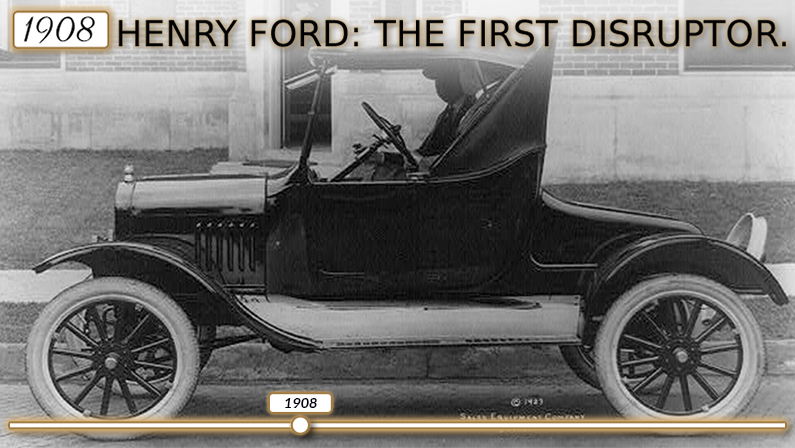
Ford modernizes the production process.
While Henry Ford didn't invent the automobile, many credit him with creating our modern manufacturing and marketing plans.
The Ford Motor Company refined auto manufacturing by installing conveyor belt assembly lines. This huge step, combined with other innovations, made cars affordable for many Americans. The company didn't advertise but instead had their dealerships do so for them.
Ford also instituted $5/day pay for his factory workers and a five-day work week. His employees could afford the cars they were making and would have time off to vacation in them.
Curious as to how much a Model T would cost today? Based on inflation rates since then, an early model costing $850 would be the equivalent of $25,223.10 in today's money.
General Motors
Founded in 1908 as a holding company, William C. Durant formed General Motors with partner Charles Stewart Mott. They drew inspiration for the name from General Electric.
GM introduced the idea of new model years and expanded its selection of autos -- entry-level, mid-entry, and luxury vehicles -- with differing brand names.
GM was the most prominent worldwide automaker for 77 years, lasting from 1931 to 2008.
Ford Motor Company
The first Model T rolled off the line in 1908 and continued production until 1927. Henry Ford famously said that you could get a Model T in any color as long as it was black.
Why black? Because the paint dried faster. Faster-drying paint meant his factories could produce more cars each day.
After the Model T came the Model A. Ford sold 2 million of this new model by July of 1927.
In 1932, Ford launched its first V8 engine in a low-cost car.
While Ford was successful, it wouldn't be until 1939 that the company began to expand its brands to capture a fuller range of potential buyers.
Chrysler Corporation
Chrysler Corporation was the latecomer of the Big Three. Walter Chrysler founded the company on June 6, 1925.
Chrysler introduced his first cars nearly 1-1/2 years before he formed the Chrysler Corporation. Maxell Motors displayed the original Chrysler at the January 1924 New York Automobile Show.
From 1936 through 1949, Chrysler held second place in US sales.
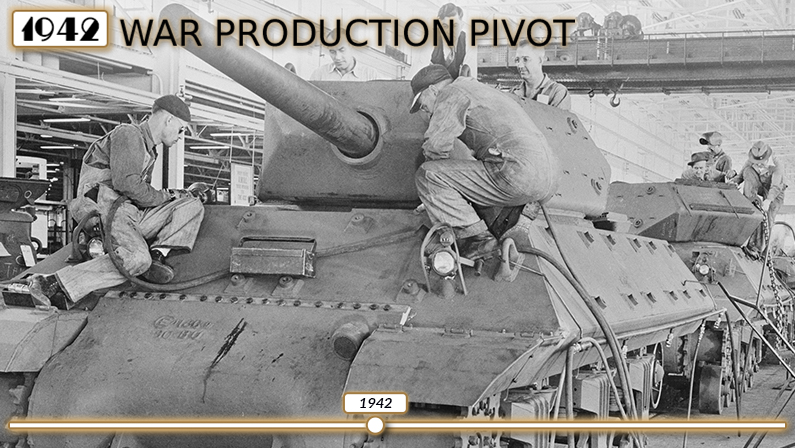
World War II changes US auto manufacturing.
On February 1, 1942, in response to requests from the government, Detroit automakers stopped making cars and trucks for civilians and switched to military production.
GM was the biggest military contractor when full production began for the war effort. The company made:
· 119,562,000 shells
· 206,000 aircraft engines
· 97,000 bombers
· 301,000 aircraft propellers
· 198,000 diesel engines
· 1,900,000 machine guns
· 854,000 military trucks
In addition to not allowing cars for the civilian market, the government rationed consumers' gas, parts, and tires. The used car market exploded at the time as people needed parts to keep their vehicles running.
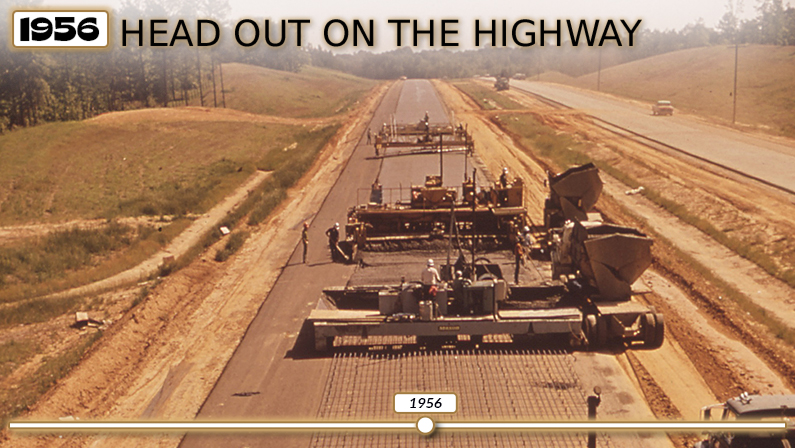
The interstate system makes road trips easier than ever before
After 20-something years of congressional debate, President Dwight Eisenhower signed the Federal-Aid Highway Act in 1956. The legislation authorized $25 billion to construct 41,000 miles of Interstate Highways in 10 years. Today, the US Interstate system is now 46,876 miles long. Ask anyone who drives the US Interstate system, and they'll tell you those roads have been under construction every summer since then.
This bill wasn't the first highway funding legislation in the US. That designation goes to The Federal Aid Road Act of 1916. The act provided 50-50 matching funds to states -- up to $75 million -- to build 6% of statewide roads over five years. However, the small amount of funding lead to little progress.
Eisenhower was a proponent of the Interstate system for a few reasons. As a 28-year-old lieutenant colonel in 1919, he volunteered to join a cross-country convoy of 81 military vehicles. Due to the poor quality of the average American road, it took the 2-mile-long caravan 62 days to travel 3,242 miles across 11 states. They averaged just 52 miles per day.
The military man also saw the need for a system that would allow for a rapid response by the military if the country was ever attacked. The interstate highways would let military vehicles and troops quickly deploy anywhere in the mainland US.
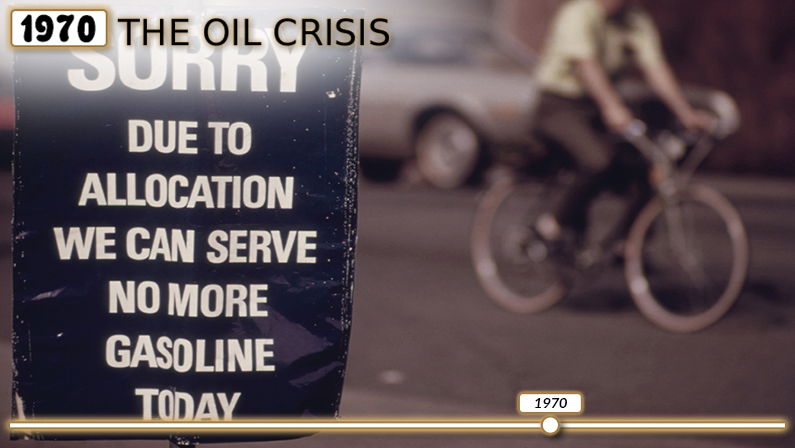
The end of cheap gas
For the first 70 years of the history of cars, gas in the US was incredibly cheap. Thanks to this, automakers could produce gas-guzzling, high-horsepower cars without issue.
Then came the wars and political challenges in the Middle East.
The Organization of Arab Petroleum Exporting Countries proclaimed an oil embargo on countries that supported Israel in the Yom Kippur War. That included the US, which was a key ally of Israel.
In May 1973, Americans paid 38.5 cents per gallon. By July, it had already hit 55 cents per gallon.
At the time, American cars averaged less than 12 mpg.
When the embargo ended six months later, oil went from $3 per barrel to $12 -- a 300% increase.
In response, the US began to increase domestic oil production, decrease highway speed limits, and work towards increased fuel efficiency. Automakers also started looking at ways to improve their cars regarding gas mileage. Gas prices never returned to their pre-embargo levels.
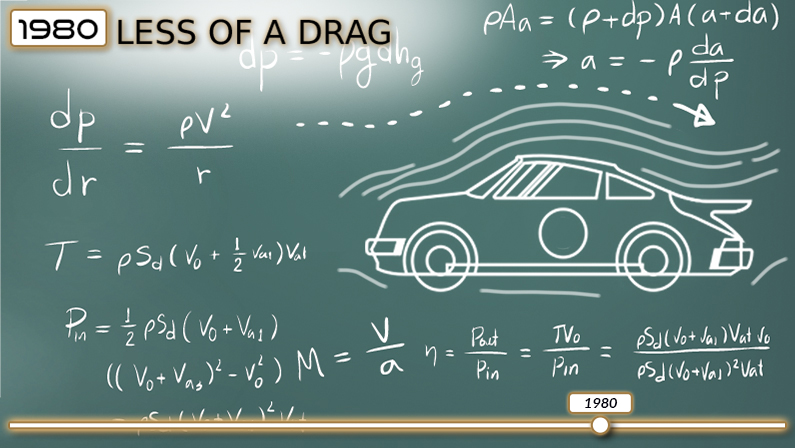
Aerodynamic designs for better fuel economy
In 1975, the US introduced the Corporate Average Fuel Economy (CAFE) program. By the 1978 model year, the rule said automakers must improve fuel efficiency to 18 mpg. By 1985, the standard was 27.5 mpg.
One way to improve fuel economy was by improving aerodynamics. Soon, Detroit replaced its classic boxy cars with curved lines that allowed the wind to flow better over the vehicle. These new designs resulted in less drag, which meant the car didn't have to work so hard to achieve higher speeds.
In his book Auto Opium: A Social History of American Automobile Design, historian David Gartman said, "One Ford designer claimed that while it would cost $200 to $300 million to achieve a one-tenth-mile-per-gallon increase by engineering 'under the hood,' aero design achieved a three- to four-tenths mpg increase for almost nothing."
The 2021 US vehicle fleet average is now 36 mpg. The goal now? To reach 40 mpg by 2026.

Technology under the hood and in your hands
In the past, you'd have to describe the weird noise coming from under the hood and hope the mechanic knew what you were talking about. With the advent of onboard diagnostic systems in the 1990s, mechanics could now plug in a special reader to see what was wrong.
California really pushed the technology forward, and in 1994, California Air Resources Board mandated OBD capabilities for all cars sold in the state by the model year 1996. That specification extended to all automobiles sold in the US by 1996.
In 1996, GM launched the OnStar system, which used mobile phones to call 911 if a driver was involved in an accident.
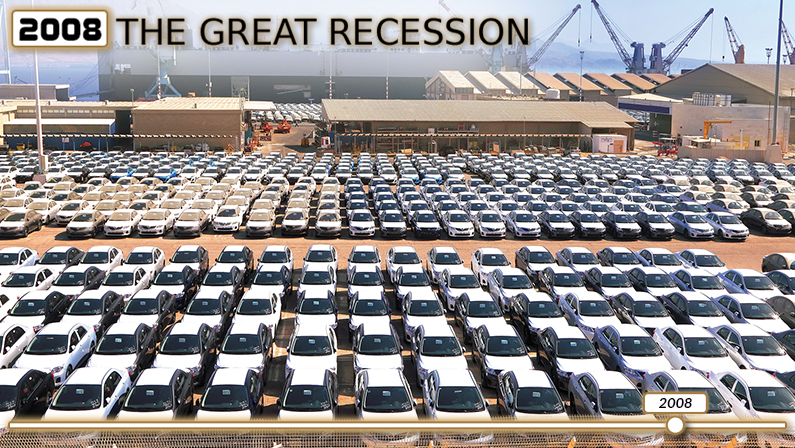
The recession and the auto bailout
The Great Recession may have started in the housing market, but it also brought financial problems for the Big Three US automakers.
As SUVs were a leading moneymaker for the companies, they continued to make them instead of smaller passenger cars. But when the recession hit, some buyers realized they needed a more fuel-efficient vehicle, or they wouldn't be able to afford their current payments. At the same time, credit markets froze, making it hard to get financing on new cars.
As a result, US auto sales dropped by about 6 million units per year between 2005 and 2008. GM and Chrysler both were looking at bankruptcy in the immediate future. Ford had gotten a line of credit in 2007 to help bridge the gap, but no one knew how long this would last.
The US and Canadian governments provided the Big Three with an $85 billion bailout to keep these key companies afloat. The deal allowed the auto companies to restructure via Chapter 11.
The US Treasury emerged as GM's largest shareholder due to the bailout. Chrysler, now owned by its employees and Fiat, repaid its loan on May 24, 2011.
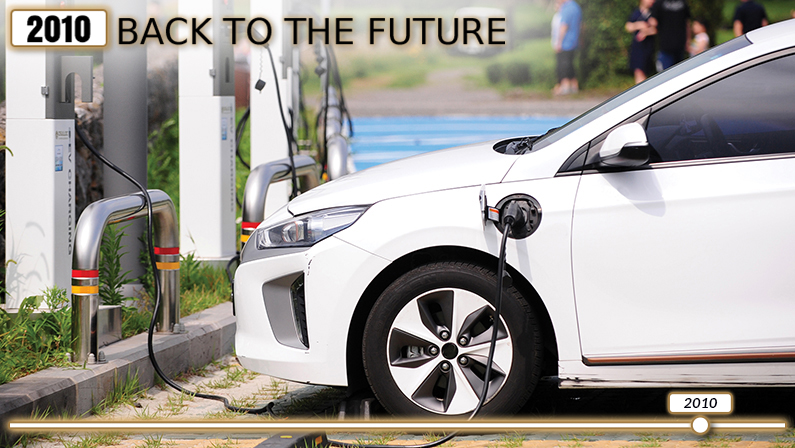
Electric cars are reintroduced after 100 years.
In the early days of automotive history, there were electric cars and gas/electric hybrids. However, gas was cheap, and since gasoline engines went farther on a tank than an electric car did on a charge, they quickly died out once Ford introduced the Model T.
In 1996, GM attempted to reintroduce the electric car concept with their EV1. GM made and leased this electric vehicle until 1999. By 2002, the company crushed nearly all the cars and ended the program due to poor sales. At least one EV1 exists in the Smithsonian National Museum of American History.
At the same time, Toyota and Honda introduced their first hybrid models. The Toyota Prius was presented worldwide in 2000, after its 1997 release in Japan, following the Honda Insight, which came out worldwide in 1999.
Of course, you can't talk about electric cars without mentioning Tesla these days. In 2010, Tesla Motors received a $465 million loan from the Department of Energy's Loan Programs Office to build a manufacturing facility in California. Tesla repaid the loan nine years early. Since its inception, Tesla has won wide acclaim for its cars and has become California's largest auto industry employer.
In October 2021, Tesla reported it had sold 2 million EVs worldwide, making it the most successful EV manufacturer and seller to date.
Other carmakers, including the former Big Three, are now joining the electric revolution.
GM has released their new Hummer EV in late 2021 and has promised an electric Corvette in 2023. The company has also said it will have an all-electric lineup across its brands by 2035. That is the year California's CARB regulations want all-electric cars on its roads.
The Ford F-150 Lightning began rolling off the line in Dearborn, Michigan, on April 26, 2022. Ford says it had 200,000 preorders for the electric pickup truck. Ford released an electric version of their iconic Mustang, dubbed the Mach-e, in 2020.
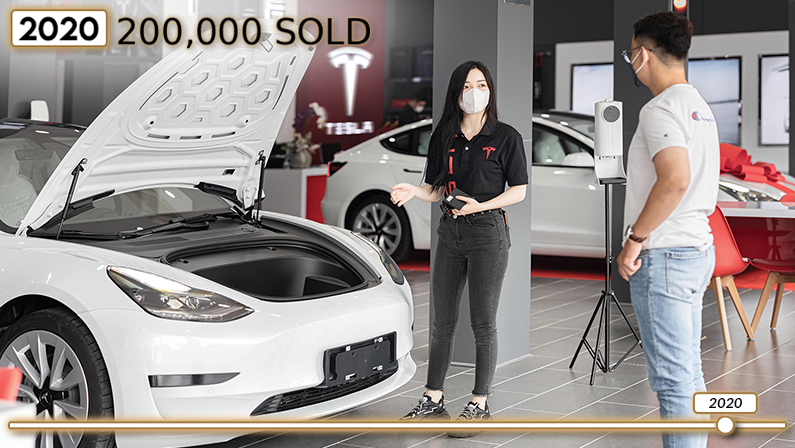
Shaking up the dealership system.
If you want a Tesla, you can order one online or go to one of its showrooms. That's because Tesla owns all of its retail fronts, which 48 states previously said 'no' to for other car manufacturers.
According to Tesla's Elon Musk, traditional car dealerships sell gas-powered cars. How can they sell buyers on an EV when they are also trying to sell them a gas-powered car?
State legislatures crafted dealership laws to protect franchised dealerships from the automakers. The idea was to prevent automakers from opening showrooms and undercutting the franchisees.
However, Tesla doesn't have franchises.
Their cars also don't need oil changes, tuneups, or emissions checks. Lifting a foot from the accelerator slows the car down, so brake pads last longer. Electric vehicles simply don't have the same maintenance demands. Maintenance is a big moneymaker for dealerships and one of the reasons why many drivers will buy from them instead of smaller dealers.
As of 2022, 16 states have banned Tesla sales centers. Some of these states have Tesla galleries where you can learn about the cars but can't buy one or even talk about buying one.
Nine other states now allow direct sales to keep up with consumer demands.
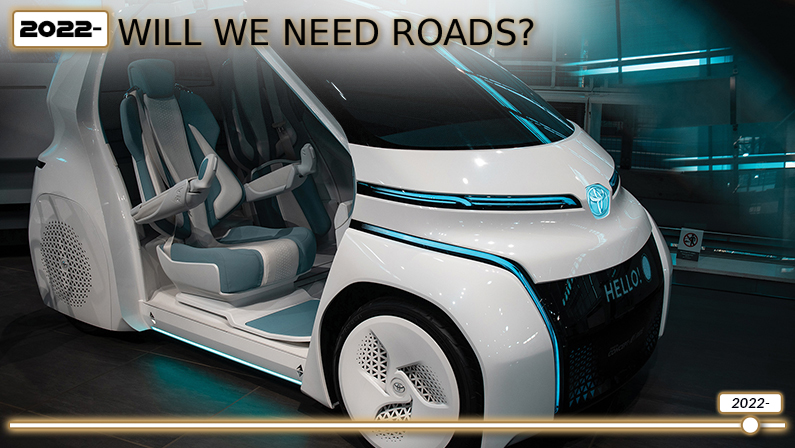
What's next for automobiles and drivers?
The next significant innovation in the auto industry may be solid-state batteries. Several makers are working on batteries that charge faster, offer more miles per charge at faster speeds, and do not heat up the way lithium batteries do. These new batteries would also have longer life cycles than the current iterations.
Of course, there's also the idea of flying cars. They've been promised since the Jetson cartoons of the 1960s and show up in just about all our modern sci-fi thrillers. Soaring above the road means summer highway construction delays would be a thing of the past.
Fiat Chrysler is working on a flying car, as are other automotive start-up companies. Some makers promise they will be on the market by 2024.
With less than 150 years of automobile history behind us, more innovations are just down the road. One day we could see the internal combustion engine go the way of the horse and buggy. Our cars may run on fuel cells and never need an oil change or stop at the gas pump again.
Whatever comes, we'll always have an open road in front of us and want to see where it goes next.








